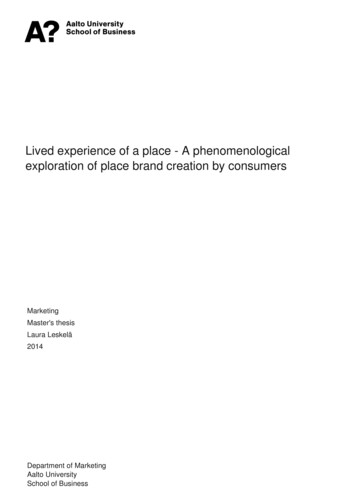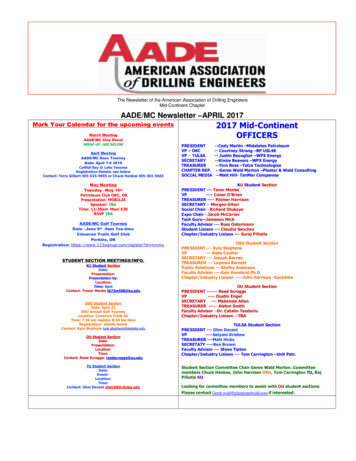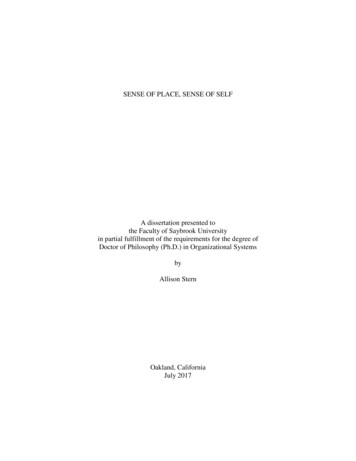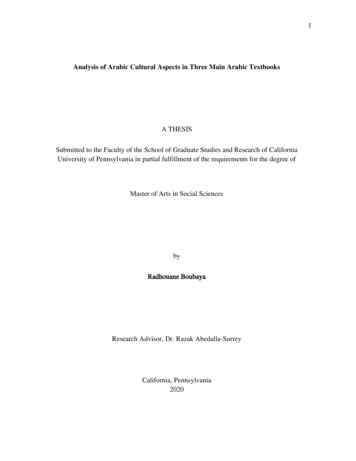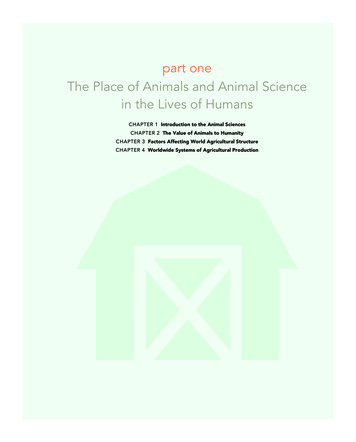
Transcription
M01 DAMR6050 06 SE C01.indd Page 1 1/17/17 10:23 AM user/203/PH02929/9780134436050 DAMRON/DAMRON INTRODUCTION TO ANIMAL SCIENCE GLOBAL BI .part oneThe Place of Animals and Animal Sciencein the Lives of HumansChapter 1 Introduction to the Animal SciencesChapter 2 The Value of Animals to HumanityChapter 3 Factors Affecting World Agricultural StructureChapter 4 Worldwide Systems of Agricultural Production
M01 DAMR6050 06 SE C01.indd Page 2 1/17/17 10:23 AM user/203/PH02929/9780134436050 DAMRON/DAMRON INTRODUCTION TO ANIMAL SCIENCE GLOBAL BI .
M01 DAMR6050 06 SE C01.indd Page 3 1/17/17 10:23 AM user/203/PH02929/9780134436050 DAMRON/DAMRON INTRODUCTION TO ANIMAL SCIENCE GLOBAL BI .1Introduction to theAnimal SciencesKey TermsLearning ObjectivesAgricultureFarmerAnimal behaviorGenetic codeAnimal breedingGeneticsAnimal healthGreen revolutionAnimal tock revolutionBiotechnologyMeatCivilizationMeat scienceCultureNutrient densityDairy product scienceNutritionDietOmnivoreDomestic animalsPhysiologyDraft animalRenewable resourcesEssential amino acidsAfter you have studied thischapter, you should be able to: Define animal science and allof its component parts. Describe how, why, and whendomestication occurred. Give an overview of the distribution of agricultural animalsworldwide. Explain to a nonagriculturistthe contributions of domesticanimals to humankind and thevalue of studying animal science. Describe the worldwide livestock revolution and itsimplications.IntroductionAnimals. We live with them, worship them, consume them, admirethem, fear them, love them, care for them, and depend on them. They arepart of our sustenance, our sociology, and our day-to-day lives. Becausethey are so important to us, we also study them and apply what we learnto improve their lives and enhance their roles in our lives. The branch ofscience that deals with domestic animals is animal science, which is thetopic of this book.Much of our use for animals revolves around their contributions toour food supply. To coax a more stable food supply from the land, humansdeveloped a complicated resource management system called agriculture.In agriculture, domestic plants and animals are kept to produce forhumankind’s needs. Humans have practiced agriculture for thousands ofyears and, either directly or indirectly, every person on the planet dependson agriculture for his or her daily food (Figure 1-1). Because this is true, itis also ultimately true that all of humankind’s other occupations are tiedto agriculture. This is especially the case in the world’s developed countries. In fact, the entire urban industrial complex of the developed worldis sustained only because of food surpluses generated by agriculturists.Animal science The combination of disciplines thattogether comprise the studyof domestic animals.Agriculture The combination of science and art usedto cultivate and grow cropsand livestock and processthe products.Domestic Those speciesthat have been broughtunder human control andthat have adapted to lifewith humans.
M01 DAMR6050 06 SE C01.indd Page 4 1/17/17 10:23 AM user4 part one/203/PH02929/9780134436050 DAMRON/DAMRON INTRODUCTION TO ANIMAL SCIENCE GLOBAL BI .the place of animals and animal science in the lives of humansFigure 1-1Bolivian farmers cultivatingpotatoes on old Incan terraces. They use the sametools as those used by theirancestors. (Roberto Faidutti/United Nations Food & AgriculturalOrganization.)Culture In this context, culture refers to the set ofoccupational activities, economic structures,beliefs/values, social forms,and material traits thatdefine our actions and activities.Hunter-gatherer Huntergatherer people supporttheir needs by huntinggame, fishing, and gathering edible and medicinalplants.Farmer Anyone who practices agriculture by managing and cultivating livestockand/or crops.Civilization In modern context, this refers to what weconsider a fairly high levelof cultural and technologicaldevelopment.Humans have found many other uses for domestic animals in such areas assports, recreation, manufacturing, religion, scientific research, and as companions.Add these uses to food production and we discover that animals are at the core ofvirtually all of our lives, whether or not we are aware of it. Because agriculture andits animals are integral to our existence, they have become a dominating part of ourculture, our influence on the landscape, and, either directly or indirectly, our dayto-day activities.Exactly when individual animal species were domesticated is unknown. DNAsequencing technology suggests that the dog was domesticated from a now extinctwolf as long as 30,000 years ago, but archaeological evidence suggests that the dog wasdomesticated about 14,000 years ago (12000 b.c.). The earliest domestic food animalspecies (as most Westerners currently define it) was the sheep (somewhere around8000 b.c.), followed by goats, pigs, and cattle (6500 b.c.); llamas (5500 b.c.); horses(3500 b.c.); donkeys (4000 b.c.); reindeer (3000 b.c.); and chickens (6000 b.c.). Note:This is a very active area of research with other dates being proposed for all species.Humans did not plan their dependence on the animals they tamed and thendomesticated. Hunter-gatherers (who first domesticated animals) used the meat,bones, and skins just as they had done before domestication. The only difference afterdomestication was convenience. The additional uses (milk, clothing, power, war,sport, and prestige) came later. This happened after people had lived in the companyof animals for a long time in a more sedentary lifestyle.Humans had hunted and consumed animals for 2 million years before domesticating them. The behavioral change required for hunters and gatherers to becomefarmers was a major cultural revolution and a major step toward what we callcivilization.With our acquisition of domestic animals came the need to ultimately managethem, care for them, and learn to use them to our best advantage. Meeting those needsled to the development of the discipline of study that we call animal science.
M01 DAMR6050 06 SE C01.indd Page 5 1/17/17 10:23 AM user/203/PH02929/9780134436050 DAMRON/DAMRON INTRODUCTION TO ANIMAL SCIENCE GLOBAL BI .introduction to the animal scienceschapter one 5Animal Science SpecialtiesAnimal science is simply the collective study of domestic animals. This includesevery aspect, from conception to death, behavior to management, physiology tonutrition, and reproduction to product distribution. Animal science represents anaccumulation of knowledge that began with observations of those hunter-gathererswho began the process of domestication long ago. As animal scientists have learnedmore and more about animals, the accumulated wealth of information has becometoo large for any one person to comprehend completely. Out of necessity, its study isdivided into disciplines, or specialties, as a means of creating manageable pieces.These specialties may be broken down several ways, but the following categoriesillustrate the point: Genetics is the science of heredity and the variation of inherited characteristics.Animal breeding is the use of biometry and genetics to improve farm animal production. Genetics is an expanding field due largely to steady progress in decipheringthe genetic code. Nutrition is the study of how organisms take in and use food/feed for body needs.Whether or not animals develop their genetic potential depends on their environment. The most important environmental factor is feed. Nutrition is the sciencethat combines feeds with feeding management to bring about the economical production of livestock and/or health and long life to animal companions. Physiology is the study of the mechanisms of life from the single biochemical reactions in cells to the coordinated total of specialized cells that constitute a livinganimal. Because physiology is complex, we usually break down the study to theworkings of physiological systems. Examples include reproductive physiology, renalphysiology, and exercise physiology. Animal health is the study of how diseases, parasites, and environmental factorsaffect productivity and animal welfare. Disease is defined as any state other than astate of health. Animal behavior and welfare developed along with the livestock industry’sincreased dependence on confinement rearing systems, which provide greater control over animals, reduce labor and feed costs, and help maximize genetic potential.Animals in these systems often present problems in their behavior. It includes animal welfare assessment, optimizing production, behavioral control, behavioral disorders, and behavioral genetics. Meat science deals with the handling, distribution, and marketing of finished meatproducts. Meat is defined as the edible flesh of animals that is used for food. Meatby-products are all of the products other than the carcass meat, some of which areedible and some of which are not. Dairy product science deals with the collection, handling, and marketing of milkin its many forms to the consuming public. Biotechnology involves technological applications of biology. This discipline hasreceived new attention in animal science because of recombinant DNA. Each of theother disciplines of animal science has benefited from biotechnology and will continue to do so at an ever-increasing rate.Certainly, tremendous overlap occurs in these areas, and separations are made forour convenience. However, this convenience can also be a hindrance. By breaking thediscipline of animal science down into smaller units, we have made it easier to learnbut harder to grasp—we know the pieces of the puzzle better, but it is harder to putthe pieces together. Always remember that it is the combination of the specialties thatconstitutes the whole discipline of animal science.Genetics The science ofheredity and the variation ofinherited characteristics.Heredity The transmissionof genetic characteristicsfrom parent to offspring.Animal breeding The useof biometry and geneticsto improve farm animal production.Biometry The application ofstatistics to topics in biology.Genetic code The set ofrules by which informationencoded in genetic material(DNA or RNA sequences) istranslated into proteins(amino acid sequences) byliving cells.Nutrition The study ofnutrients and how the bodyuses them.Physiology The study ofthe physical and chemicalprocesses of an animal orany of the body systems orcells of the animal.Animal health The studyand practice of maintaininganimals as near to a constant state of health as ispossible and feasible.Animal behavior The studyof animal welfare assessment, optimizing production, behavioral control,behavioral disorders,and behavioral genetics.Meat science The scienceof handling, distributing,and marketing meat andmeat products.Meat The flesh of animalsused for food.Dairy product science Thescience of providing milkand milk products as food.Biotechnology A collectiveset of tools and applicationsof living organisms, or partsof organisms, to make ormodify products, improveplants or animals, ordevelop microorganisms forspecific uses.
M01 DAMR6050 06 SE C01.indd Page 6 1/17/17 10:23 AM user6 part one/203/PH02929/9780134436050 DAMRON/DAMRON INTRODUCTION TO ANIMAL SCIENCE GLOBAL BI .the place of animals and animal science in the lives of humansAnimal DistributionThere are approximately 4.9 billion large farm animals and 22.9 billion poultry distributed throughout the world (Table 1-1). The number of large farm animals has beenincreasing at an average rate of about 1% annually for several decades. During that time,there have been shifts in the size of individual species populations and their worldwideTable 1-1A gricultural A nimal N umbersWorld Totalin theSouthAmericaand theCaribbeanW orldNorth 587154,515,127986,685,399458,971,238 2,417,695,910Large Farm AnimalsCattle (head)1 1,443,524,363Sheep (head)1,149,162,250Pigs (head)978,658,479Goats (head)962,157,224Buffalo (head)193,566,739Horses (head)58,257,819Asses (head)43,430,035Camels (head)24,136,822Mules (head)10,246,096Other abbits and Rodents3Rabbits(1,000 head)Other rodents4(1,000 886160930559,058PoultryChickens(1,000 head)Ducks(1,000 head)Geese andguinea fowl(1,000 head)Turkeys(1,000 head)Total(1,000 head)InsectsBeehives (number)Silkwormcocoons (MT)Source: Food and Agriculture Organization of the United Nations, 2016, http://faostat3.fao.org/download/Q/QA/E. Reproduced with permission.1Includes yaks.2Includes both llamas and alpacas.3Producing animals slaughtered.4Primarily guinea pigs.
M01 DAMR6050 06 SE C01.indd Page 7 1/17/17 10:23 AM user/203/PH02929/9780134436050 DAMRON/DAMRON INTRODUCTION TO ANIMAL SCIENCE GLOBAL BI .introduction to the animal scienceschapter one 7Table 1-2C ontributionsofA nimalstoH uman S ocietiesFoodEggsMeatMilkBloodFatEdible slaughter by-productsBody CoveringsWoolLeather, pelts, hidesHair, fur, feathersWorkDraft and other laborTransportationBody WastesFuelFertilizerConstruction materialAnimal feedOther UsesIncomeStorage of capitalStorage of foodBiomedical research modelsContributions to the economyBuffer for fluctuating grain suppliesSoil fertility enhancementPrestigeReligion and other cultural needsSlaughter by-productsRecreation and sportPest and weed controlCompanionship and servicePet foods and treatsConservationSources: Compiled from A partnership for humans and animals by R. E. McDowell, Agricultural animalsof the world by E. J. Turman.distribution. Poultry numbers have increased more rapidly at an average rate of over 5%annually. Until very recently, greater than two-thirds of the large farm animals werefound in developing countries, but they produced only about a third each of the meat,milk, and wool produced in the world due to environmental stresses, disease challenges,lack of access to technology, and different objectives of livestock production. However,the world agricultural order is undergoing profound changes, which are causing a greaterpercentage of the world’s livestock to be found in the developing world. In addition, theproductivity of the livestock in the developing world is improving dramatically.Agricultural animals have made a major contribution to the welfare of humansocieties for millennia by providing a variety of products and services, as shownin Table 1-2. They are a renewable resource, and they use another renewableresource—plants—to produce these products and services.Contributions of Animals to HumanityRenewable resourcesThose resources that can bereplaced or produced bynatural ecological cycles ormanagement systems.A detailed look at animal use comes later in this book. This section briefly surveyssome of the many contributions of livestock and other animals to humans.Food SourceHumans are omnivores, consuming both plant- and animal-based foods. Figure 1-2shows the contributions of different food sources to the world food supply. Althoughfood is the most important contribution of agricultural animals to humans, plantsOmnivore An animal thateats both animal- and plantbased feeds.
M01 DAMR6050 06 SE C01.indd Page 8 1/17/17 10:23 AM user8 part one/203/PH02929/9780134436050 DAMRON/DAMRON INTRODUCTION TO ANIMAL SCIENCE GLOBAL BI .the place of animals and animal science in the lives of humansFigure 1-2Contributions of foodsources to humanenergy (calorie)consumption.Fish, seafood, and aquaticanimals 1.18%(Source: Food and Agriculture Organization ofthe United Nations, 2016,http://faostat3.fao.org/download/Q/QA/E. Reproduced with permission.)All animalproducts17.7%Animal fats 2.13%Eggs 1.22%Milk 4.84%Meat and offal 8.29%Miscellaneous plantproducts 0.70%Alcoholic beverages2.40%Vegetables and fruits6.52%Cereals 45.16%Sugar, sugar crops, andsweeteners 8.15%Starchy roots and pulses7.18%All vegetableproducts82.3%Treenuts, oilcrops, andvegetable oils 12.20%supply a greater total quantity of food. Plants supply approximately 82.3% of the totalfood energy consumed by the world’s people, primarily because such a high percentageof the human diet in the developing countries is of plant origin. Animal products supplyapproximately 17.7%. In developed countries, animals contribute a greater percentageof the total food energy. In the United States, for instance, they provide 27%. Animalsare a more important source of protein than they are of calories (Figure 1-3), supplying40% of the protein consumed in the world. Of the animal protein sources, meat provides approximately 48.4%, milk provides approximately 26%, fish supplies approximately 17%, and eggs supply 8.6%. Developed countries obtain a greater percentage oftheir total protein from animal products. The United States, for example, gets approximately 66% of its protein from animal products. Table 1-3 shows a more completepicture of the contribution of various foods to the U.S. food supply.Figure 1-3Contributions of foodsources to human proteinconsumption.(Source: Food and Agriculture Organization of the United Nations, 2016,http://faostat3.fao.org/download/Q/QA/E. Reproduced with permission.)Meat and offal19.44%All animal products40.17%Fish, seafood, andaquatic animals6.83%Cereals 40.42%Eggs 3.44%Milk 10.46%Treenuts, oilcrops,and vegetable oils3.98%Vegetables andfruits 7.43%Starchy roots andpulses 8.00%All plantproducts59.83%
ry, 50225241322EggsF ood G roupingDairy(Excl. 6in440001033647758198067128511VegetablesV arious N utrientsTotal Animalto364255007052448057158620Legumes,Nuts, Soy2321221407466038432071051924512522GrainsT he U.S. F ood S upplySource: Agricultural statistics, United Stated Department of Agriculture.1Coffee, tea, chocolate-liquor equivalent of coca beans, spices, and fortification of foods not assigned to a specific group.2SFAs saturated fatty acids; MUFAs monounsaturated fatty acids; PUFAs polyunsaturated fatty acids.EnergyProteinTotal fatSFAs2MUFAs2PUFAs2CholesterolVitamin AVitamin EVitamin CThiaminRiboflavinNiacinVitamin B6FolateVitamin tP ercentage C ontributionTable 0000000000Fats andOils15000000000010000101101Sugars andSweeteners121111020112321044149415Misc.1M01 DAMR6050 06 SE C01.indd Page 9 1/17/17 10:23 AM user/203/PH02929/9780134436050 DAMRON/DAMRON INTRODUCTION TO ANIMAL SCIENCE GLOBAL BI .
M01 DAMR6050 06 SE C01.indd Page 10 1/17/17 10:24 AM user10 part oneNutrient density A measurement of the nutrientsprovided in a food comparedto the calories it contains.Diet The total of the foodsand water being consumedby an individual or group.Essential amino acidsThose amino acids requiredby the body that must beconsumed in the diet.Undernourished Receivinginadequate nourishment forproper health and growth./203/PH02929/9780134436050 DAMRON/DAMRON INTRODUCTION TO ANIMAL SCIENCE GLOBAL BI .the place of animals and animal science in the lives of humansMeat, eggs, and dairy products are important food sources because they arenutrient dense. This means they have many nutrients compared to their calories, andthe nutrients are digestible and readily available. High-quality protein and biologically available levels of vitamins and minerals, as well as a significant amount ofenergy, are supplied to the diet by animal foods.Animal foods are generally preferred over plant foods by human populations,and the vast majority of the world’s population routinely chooses food produced fromanimals in its diet. A country’s living standards can be gauged by the proportion of itsfood supply that consists of animal foods. Time and again, people have demonstratedthat increasing animal-derived foods in their diet is one of the first things they will dowhen their income increases. Not only are animal foods palatable and delicious, theyare also the most nutritionally complete foods. They are an important source of vitamins and minerals, and the protein in animal foods is more likely than are plant proteins to include the essential amino acids in the correct proportions.Absolute food quantity and amount of animal products are more available to someof the world’s people than to others. Approximately 27.8% of the calories in the averagediet in North America are from animal products compared to 8.4% for the average African. There is also a tremendous difference in food distribution to the world’s people.The average African eats only 72% of the daily calories eaten by the average NorthAmerican. Globally, 795 million people are undernourished.Most people include meat and dairy products in their diets whenever they can.Exceptions are almost always because of religious prohibitions, principally beef andpork, or because of prohibitive costs. The world’s meat (excluding fish) is predominantly supplied by pigs, cattle, and poultry with lesser amounts from sheep, goats,buffalo, and horses. Several other species provide a significant amount of meat to thepeople of various geographic regions. Most milk comes from cows, but buffalo, goats,and sheep provide significant amounts of milk, and most domestic hooved animals aremilked somewhere in the world.Other UsesIn addition to food, other animal products are also of great importance to humans,who have used wool, hair, and other fibers for clothing, and feathers and hides forleather footwear and apparel, even baseball gloves. Manure from animals is a valuableby-product used for fertilizer and other applications (Figure 1-4).Figure 1-4Liquid manure from a hogfeeding operation in Iowa isbeing pumped onto cropland with a “honey wagon.”(Tim McCabe/U.S. Department ofAgriculture.)
M01 DAMR6050 06 SE C01.indd Page 11 1/17/17 10:25 AM user/203/PH02929/9780134436050 DAMRON/DAMRON INTRODUCTION TO ANIMAL SCIENCE GLOBAL BI .introduction to the animal scienceschapter one 11Figure 1-5Draft animals are still themost important nonhumanpower source in developingcountries. ( FAO/G.De Sabatino.)Slaughter by-products are the source of a large number of industrial and consumer products. Some examples include pharmaceuticals, insecticides, crayons, cosmetics, plastics, cellophane, glass, water filters, plywood adhesive, soap, gelatin, airfilters, and animal feed.Draft animals are vitally important to many Asian, African, and Latin Americancountries. Oxen plow fields; water buffalo work in rice paddies; yaks, donkeys, andcamels still trudge over ancient trade routes; and dogs still pull sleds (Figure 1-5).Much of the world’s food production in less developed regions is dependent on draftanimals, as is transportation of goods to and from markets. Tasks such as carryingwater and fuel are significant contributions of draft animals. As much as 80% of thenonhuman power of subsistence agriculture is provided by draft animals.Animals are used as models for humans in biomedical research, helping to extendhuman life span. Thirty years have been added to the average American life span since1900. In addition, the quality of life for people afflicted with chronic diseases has beenimproved dramatically. Medical research depends on the use of animals as models. Itwill continue to do so in the foreseeable future (Figure 1-6). In addition, animals areDraft animal An animalwhose major purpose is toperform work that involveshauling or pulling. An ox ora horse pulling a plow orwagon is a draft animal.Figure 1-6Biomedical research depends on the use ofanimals as research models.This two-year-old Spanishgoat underwent a successfulcleft palate repair in utero.Goats were first developedas an animal model for thestudy of lupine-inducedcrooked calf syndrome. Themodel is now playing a rolein developing proceduresfor prenatal repair of cleftpalate in children.(Peggy Greb/USDA-AgriculturalResearch Service.)
M01 DAMR6050 06 SE C01.indd Page 12 1/17/17 10:26 AM user12 part one/203/PH02929/9780134436050 DAMRON/DAMRON INTRODUCTION TO ANIMAL SCIENCE GLOBAL BI .the place of animals and animal science in the lives of humansFigure 1-7Service dogs help peoplewith disabilities. Here, aSeeing Eye dog in action,with student and instructor, on the streets of Morristown, New Jersey. Thedog has stopped the personfrom proceeding across thedriveway as the van turns.(Photo Courtesy of The SeeingEye, Inc.)Figure 1-8Many entertainment industries are based on animaluse. Horse racing is amongthe most popular. (ClarenceAlford/Fotolia.)Livestock revolutionLarge increases in supplyand demand of livestockand animal productsworldwide at the end ofthe 20th century and intothe 21st century.Green revolution Dramatic improvementsin grain production indeveloping countriesduring the 1960s to the1980s because of technological innovation andapplication.used in research to benefit animal health, resulting in healthier, longer-lived pets andhealthier, more productive livestock.Animal companionship is important to people around the world, enhancinghuman physical, emotional, and spiritual well-being. Specially trained animals assistpeople with visual disabilities (guide animal), hearing disabilities (hearing or signalanimal), and other disabilities (service or assistance animal), helping people live moreindependently (Figure 1-7). Therapy animals are commonplace.In addition, many entertainment industries such as racing, rodeos, and bullfighting are based on animal use (Figure 1-8).Agricultural animals convert inedible feeds to valuable products. About twothirds of the feed used in the U.S. livestock industry is not suitable for human consumption. Hay, pasture, coarse forages, by-products, garbage, and damaged food areexamples. Animal use diversifies agriculture, the food supply, and the economy.Diversified agriculture is more stable and more sustainable.The Future of Livestock ProductionGlobal livestock production is undergoing huge increases in animals and productswith further increases predicted. To keep pace with demand, many are predicting theneed to double animal product output by 2050. This increasing animal production isbeing referred to as the livestock revolution, and it is being likened to the cerealgrains boom of the green revolution, which began in the 1960s and is credited withsaving millions of lives and building many national economies.The forces driving increased global demand for animal products are simple: humanpopulation growth and increasing income. Unprecedented economic development
M01 DAMR6050 06 SE C01.indd Page 13 1/17/17 10:26 AM user/203/PH02929/9780134436050 DAMRON/DAMRON INTRODUCTION TO ANIMAL SCIENCE GLOBAL BI .introduction to the animal sciencesaround the world is increasing per capita income. The world’s human population isincreasing and is projected to reach approximately 9.6 billion by 2050. These factors arecausing increased per capita consumption of animal products and large increases in totaldemand. Most of the new demand for animal products is in developing countries, whichare expected to soon produce the majority of the world’s meat and milk. Along with theincreased demand for animal products is an increased demand for other agriculturalcommodities to feed people and livestock. In addition, the world’s developing demandfor biofuel production will increasingly play a role in food availability and prices.The challenges associated with these profound changes in agriculture are significant. The prime agricultural lands are already in use, and, worldwide, the potential newagricultural lands are covered by forests, under human settlements and infrastructure,or likely to be marginally productive. With increased human population, agriculturalland per person will continue to decrease. Therefore, agricultural land will need to bemore productive. To make this happen, there is a pressing need for research and subsequent technology development to increase productivity per unit of land. Agriculture ofall kinds has the potential to affect the environment both negatively and positively. Forthe sake of future generations, we must achieve these massive increases in yield whileprotecting air, soil, and water quality. Combined, the opportunities and the challengessuggest an unprecedented dynamic period in the world agricultural order.chapter one 13Per capita Per unit of population: by or for each person.Biofuel Gas or liquid fuelmade from biological materials, such as crops and animal waste.Summary and ConclusionAnimal science has its roots in the challenges that thefirst domesticators of animals encountered many millennia ago when they permanently brought in animalsfrom the wild. Today, animal science is a vital fieldwith specialties in genetics and animal breeding, nutrition, physiology, animal health, animal behavior, meatand dairy product science, and biotechnology. Animalsare used for a myriad of purposes, including food, fiber,work, research, companionship, and entertainment. lthough agricultural animals have come under attackAin recent yea
Animal breeding is the use of biometry and genetics to improve farm animal pro - duction. Genetics is an expanding field due largely to steady progress in deciphering the genetic code. Nutrition is the study of how organisms take in and use food/feed for body needs. Whether or not ani




